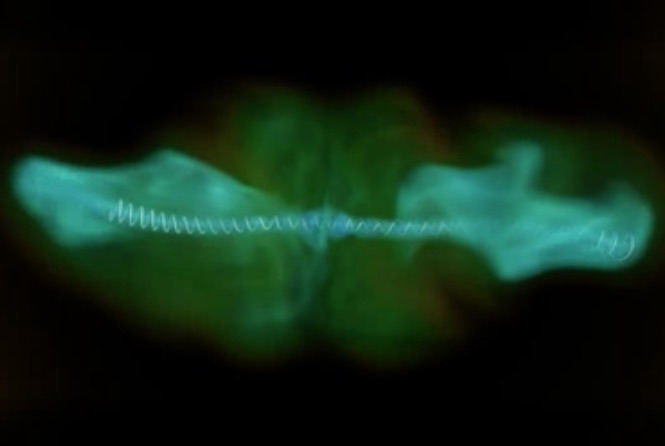Over at NICS, Scott Gibson writes that researchers are using XSEDE supercomputing resources to simulate the gaseous outflows from black holes known as astrophysical jets.

Brought to life by a gas-gobbling supermassive black hole, powerful jets drill their way out of the galaxy with only minor bends and wiggles. (Simulations by Alexander Tchekhovskoy of the University of California at Berkeley, and Omer Bromberg of Hebrew University)
With a Ph.D. in astronomy from Harvard also to his credit and the distinction of being a NASA Einstein postdoctoral fellow at the University of California at Berkeley (UC Berkeley), Alexander Tchekhovskoy uses a variety of tools — from pencil and paper to supercomputers — to explore phenomena on the frontiers of science such as black holes.
Cosmic objects so massive and gravitationally strong that nothing, including light, can escape their clutches, black holes not only consume the gas that surrounds them but also spew gaseous outflows known as astrophysical jets.
“These jets can affect galaxy formation and evolution by, for example, heating up the surroundings and suppressing star formation, expelling the surrounding gas and thereby reducing the mass supply to the black hole,” Tchekhovskoy explains.
This ambient influence of the jets, often referred to as “black hole feedback,” is a mystery that to be solved requires black hole and full-galaxy simulations.
By better understanding how the black holes affect the lives of galaxies, we will improve the understanding of how galaxies evolve and where we came from,” says Tchekhovskoy.
Using supercomputing resources provided by the National Science Foundation’s eXtreme Science and Engineering Discovery Environment (XSEDE) and the Savio computer at UC Berkeley, Tchekhovskoy and co-researcher Omer Bromberg — formerly a Lyman Spitzer Jr. postdoctoral fellow at Princeton University, and currently at the Hebrew University of Jerusalem in Israel — resolved the 40-year puzzle of the astrophysical jet dichotomy. Altogether the simulation effort took about 500 hours on 2,000 computer cores, which, for perspective, would amount to about 1 million hours on a standard laptop.
“In our work, we show that magnetic instabilities naturally lead to jet disruption at low powers characteristic of FRI jets but leave the jets stable at higher powers characteristic of FRII jets,” says Tchekhovskoy, who led the computational aspect of the project. Details of the research are provided in a paper recently published in the journal Monthly Notices Letters of the Royal Astronomical Society.
Tchekhovskoy and Bromberg’s simulations took on the daunting challenge of going from where the jets are initiated to where they deposit their energy, which means a transition from a very small scale to one that is a thousand times larger.
Darter [managed by the National Institute for Computational Sciences (NICS)], with its short-job turnaround times, was up to the challenge,” says Tchekhovskoy. “And the NICS team was very helpful in setting up the visualization tools so we could follow the simulations in real time. We have used the Texas Advanced Computing Center’s [TACC’s] Stampede to run some of these simulations, but the majority of this work was carried out on Darter. We also used TACC’s Ranch for backing up the simulation results.”
The study of black holes and their associated components such as astrophysical jets could reveal even more about the properties of gravity, one of physics’ fundamental concepts. And beyond that, as Albert Einstein said, “The important thing is not to stop questioning. Curiosity has its own reason for existing.” Lovers of science like Tchekhovskoy certainy agree.
Source: NICS





